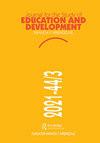Motherese in the Wichi Language (El maternés en la lengua wichí)
IF 1.8
4区 教育学
Q4 PSYCHOLOGY, DEVELOPMENTAL
Journal for the Study of Education and Development
Pub Date : 2021-04-03
DOI:10.1080/02103702.2021.1889290
引用次数: 1
Abstract
Abstract This paper provides the first evidence of maternal speech — motherese — in Wichi, an indigenous language with a complex morphology spoken in the Gran Chaco region of Argentina. The corpus consists of 22 hours of video recordings from the daily life of three children, starting from their one-morpheme utterance period (MLU = 1) to the onset of combining early morphemes (MLU = 2.30). Employing a mixed methodological approach, results allowed us: (a) to create an observational system of specific categories for the analysis of the maternal speech in Wichi; (b) to identify motherese in Wichi, noticeably stable across cases and organized into constellations of lexical, pragmatic-discursive and prosodic features with changes and continuities during the developmental target period. The results are discussed cross-culturally in the light of a renewed cultural approach, while limitations and future directions are addressed.摘要本文提供了在阿根廷大查科地区的一种具有复杂形态的土著语言Wichi中母体语言- motherese的第一个证据。语料库由三个儿童从单语素话语期(MLU = 1)到早期语素组合期(MLU = 2.30)开始的22小时的日常生活录像组成。采用混合方法,结果使我们能够:(a)创建一个特定类别的观察系统,用于分析威奇语的母亲语言;(b)识别威奇语的母语,这些母语在不同情况下明显稳定,并在发展目标时期被组织成词汇、语用-话语和韵律特征的星座,具有变化和连续性。研究结果在一种新的文化方法的基础上进行了跨文化的讨论,同时指出了局限性和未来的发展方向。
本文章由计算机程序翻译,如有差异,请以英文原文为准。
求助全文
约1分钟内获得全文
求助全文

 求助内容:
求助内容: 应助结果提醒方式:
应助结果提醒方式:


